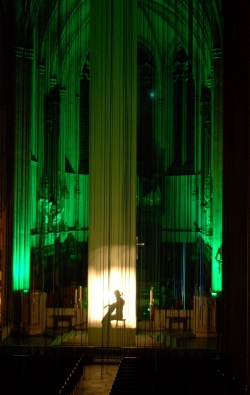By LIZ HAGER
© Liz Hager, 2013. All Rights Reserved
At some point in the recent debut of Anne Patterson’s striking work Seeing the Voice: A Synthesis of Light, Color, and Music at Grace Cathedral, my mind drifted to Piero della Francesca’s fresco cycle in the Basilica of San Francisco. On the face of it, The Legend of the True Cross would seem worlds away from Patterson’s collaboration with cellist Joshua Roman, which produced a synergistic evening of light, streamers, and music.
The pictorial art commissioned by Popes and princes from the 14-17th centuries served a fundamentally didactic purpose—to instruct a largely illiterate congregation on biblical narratives—while presumably invigorating the collective belief in mysteries and miracles (not to mention the Church’s temporal prestige).

Seeing the Voice (performance still) ©Esteban Allard-Valdivieso
In contrast, today’s literate first-world citizen is likely to be deeply skeptical of religion. If spiritually disposed at all, s/he has a seemingly infinite array of venerable and newly-minted traditions from which to create any number of hyphenated identities. As Dr. Jane Shaw, Dean of Grace Cathedral, has expressed: this à la carte mentality stems from the deep need we have to belong without wanting to believe.
Further, the decoupling of art from religion, largely accomplished by cultural shifts in the 19th & 20th centuries, means that for most of us, if we enter a contemporary sacred space at all, the last thing we might expect to see is a work of contemporary (non-figurative) art.
Understandable then that I, resolutely wary of organized religion, approached Seeing the Voice with minimal expectations. Unpredictably, the evening was a complete delight.
Patterson conceived Seeing the Voice as the debut of her year-long artist in residency at Grace Cathedral. The installation itself (which Patterson calls Graced With Light) was worth the price of admission. Some 200 miles of light-reflecting ribbon strands hung from the ceiling of the nave, catching the rays from various colored spotlights as they lazily twisted in the air currents. The effect was mesmerizing, evoking at times primitive worms responding to stimuli, a mad highway of car headlights at night, and comets in the night sky. Underneath this stage set, Roman played two cello pieces composed especially for the evening. The cellist sat behind a long white banner, while fragments of his silhouette danced and flickered on the banner as a result of some clever back lighting.
The wow factor of the evening was pretty high, even before we were invited, no encouraged, to lie in the pews and look up at the ribbons, while Roman played Bach’s Suite #4. Outstanding! Shooting meteor effect!
More than the sophisticated elegance of the installation and the interesting, often lovely music, the piece caused me to think more explicitly about the nature of art and religion. Specifically, does art have fundamentally different meaning in sacred vs. secular settings? If not didacticism (story telling), what are the effective uses of art in contemporary faith? While art certainly has a spiritual component, does it move people to become spiritual? Practically what does a spiritual life look like, if organized religion is not a component? Does art bring the non-believer closer to understanding the believing community and vice versa?
Seeing the Voice sparked me to experience art a bit differently. After a week or so of rumination, I still have no firm answers to the questions above. (See below for links to what others have said on the topic.) However, as a result of my explorations, one thing does seem evident to me. Although time and traditions separate Seeing the Voice and Legend of the True Cross, in their own ways each invites the viewer to imagine a world they don’t exactly live in. And that may be at the heart of a spiritual life.
Wider Connections
Anne Patterson—Seeing the Voice (video); Seeing the Voice is a yearlong exploration of the synthesis for the spirit with our traditional five senses. Although it is unclear whether the performance will be repeated, the installation Graced With Light will remain, growing and changing over time. Patterson is scheduled to present a new piece at Grace Cathedral this fall.
Aspen Ideas Festival: Jane Shaw—”Our Moral Imagination”, What Sustains Us
SFMOMA (in conjunction with The Contemporary Jewish Museum)—“100 Years of the Spiritual in Modern Art”
The growing intersection of contemporary art and faith: ArtNews—“The Church Gives Contemporary Art Its Blessing;” Contemporary Art Flourishes at New York City Churches
Michael Sandell—What Money Can’t Buy: The Moral Limits of Markets
Mark Rothko, Houston Chapel
Matisse’s Chapelle du Rosaire













